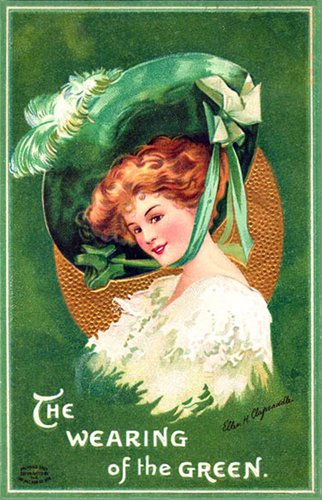This is a vintage signed Ellen Clapsaddle St. Patrick’s Day postcard showing a lovely Irish Lass with a Victorian dress and large, green Victorian hat over auburn hair. The postcard wishes a St. Patrick’s Day Greeting by mentioning “The Wearing of the Green” and is really a beautiful St. Patrick’s Day postcard that would have been sent at the turn of the 20th century. In those days, any person of Irish descent would know the term, “The Wearing of the Green” had special significance in Irish history. Ellen Clapsaddle has captured the sentiment in a lovely and elegant way.
In 1695, Britain passed laws regarding the Catholic people of Ireland. They were forbidden from schooling their children, from voting, owning land, they could not own a horse, serve on a jury, they could not be a public official, become a soldier or enter into the law in any capacity.
These laws brought a feeling of oppression to Ireland and many people stopped wearing their traditional family kilts, playing the bagpipes, or singing and dancing the songs of their past.
The Irish dancing that is so popular today shows the dancers being quit stiff from the waist up. This was due to the fact that if in looking through a window into a home, an English soldier could not see that they were dancing a “jig” as they looked stiff and still – only the feet were moving.
During the 1700s, a band of soldiers in the British Army known as “The Irish Volunteers,” led by a Protestant, Henry Grattan, became quite popular and powerful. They used their influence to lobby for the removal of the restricting laws against Irish Catholics and trade with Ireland. Henry Grattan felt that the Protestant Irish could not be truly free until the Catholic Irish were no longer slaves.
The Irish Volunteers took to wearing the Shamrock on their uniforms. England saw this as an act of rebellion and a law was passed that anyone wearing the Shamrock would be hung. From this history comes the song called, “Wearin’ of the Green” which has popularized this saying among the Irish.
But, Queen Victoria lifted this ban after the Irish Volunteers had stunning victories in the Boer War in South Africa. She sent a message out to all her troops in regards to her “brave Irish soldiers.” The message was that on St. Patrick’s Day, all ranks of her Irish regiments were to wear a Shamrock in commemoration of the bravery of the Irish troops in South Africa.
Today still, the British Royal Family presents a Shamrock to the Irish Guards in the British Army.
